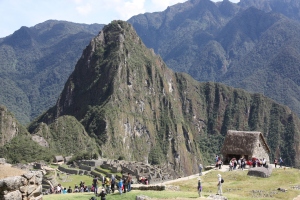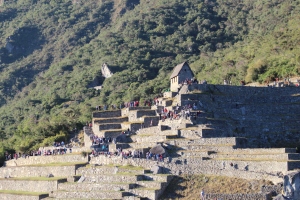The magic of Machu Picchu
There are probably a bazillion pictures of Machu Picchu online, and now there will be more.
Poor John and I have been lucky enough to visit these ancient Inca ruins twice in less that 12 months, and we’ve been completely impressed both times.
Last year we spent three days scrambling almost 30 kilometres on the up-and-down Lares Trek to get there. This time we cheated and took the train.
There’s a lot of uncertainty about Machu Picchu and its reason for being. It’s often referred to as the Lost City of the Incas. Some say it was a sacred religious site and perhaps where human sacrifices were ‘groomed’ for their doom. But more recent research has led most archaeologists to believe it was an estate for the Inca emperor, Pachacuti.
Most likely we’ll never know the real truth, but that doesn’t keep us from enjoying the remarkable structures and landscapes that create Machu Picchu.
So here are some of her details (I always think of locations as female).
Introducing Machu Picchu
First off, Machu Picchu is one of South America’s most important and most visited archaeological sites. Only 2500 visitors are allowed every day (and only 400 to adjacent Huayna Picchu), and there would be many more if the rules allowed it.
It wasn’t always so heavily visited.
A friend, who lived many years in Brazil and Chile, visited Machu Picchu twice in the late 1970s and early 1980s. Back then, he and a couple of busloads of people travelled from nearby Aguas Calientes, which sits below the complex, to the entrance.
Machu Picchu (meaning old pyramid in the local Quechua language) is the name of the archaeological site and the mountain that rises behind it. The mountain looms over a loop in the Urubamba River, and is surrounded by that river on three sides.
Built about 1450, the city is located on a saddle between Huayna Picchu and Machu Picchu. Its three main structures are the Intihuatanai (Hitching Post of the Sun), the Temple of the Sun and the Room of the Three Windows. They are part of what archaeologists call the Sacred District.
The Sacred Plaza, which is near the main temples, is 2453 metres above sea level. This lofty position means the city is often misty, and its wet season extends from October to April.
The site is divided into two sectors—urban and agricultural. The urban sector has two levels with the Sacred District sitting higher than the warehouses. Up and down the hill, and across the way on the sides of Huayna Picchu, are scores of terraces for crops.
The main buildings have the classical Inca architectural style of polished dry-stone walls. Doors and windows are trapezoidal and tilt inward from bottom to top, corners usually are rounded, inside corners often incline slightly into the rooms and L-shaped blocks are often used to tie together outside corners of structures.
The Incas were masters of this technique in which blocks of stone are cut to fit together tightly without mortar. In many places, the fit is so perfect that not even a blade of grass can be inserted between stones.
Peru is prone to earthquakes so this style of construction allows the walls to move slightly and resettle without collapsing.
No matter how well it is built, Machu Picchu was abandoned after about 100 years—no one knows exactly why—but it happened about the time of the Spanish Conquest. It’s possible that the residents died of smallpox brought by the invaders.
The invaders may have brought disease, but at least they didn’t bring their scouts to the region. Unlike most Inca structures, Machu Picchu was never found or visited by the conquering Spaniards, meaning it remained reasonably intact. (The Spanish had a habit of dismantling existing structures to make churches, houses and other buildings.)
In 1911, Hiram Bingham, an American historian and lecturer at Yale University, brought the first news of Machu Picchu to the outside world. He continued to visit and excavate at the site until 1915.
Over time, local intellectuals began to object to Bingham’s work, and local landowners accused him and his team of stealing artifacts and smuggling them out of Peru, which is exactly what they were doing.
There was a long-running dispute between the Peruvian Government and Yale University, which held the artifacts. An agreement was reached in 2010 and, by late 2012, Yale had returned all of the massive collection—thousands of items—to Peru.
In 1981, Peru declared more than 300 square kilometres surrounding Machu Picchu as a ‘Historical Sanctuary’. Two years later, UNESCO designated it as a World Heritage Site, saying it was ‘an absolute masterpiece of architecture and a unique testimony to the Inca civilization’.
A few years ago, Machu Picchu was also voted one of the New Seven Wonders of the World in a worldwide internet poll.
Our visit
On both visits, we’ve arrived at nearby Aguas Calientes the night before our trip around the ruins. There are no roads to Aguas Calientes—you can reach it only by train or on foot.
Our hostels have had comfy beds and brilliant hot showers, meaning they know how to cater for people who may have trekked a couple of days to get there.
Not that we ever got much sleep in the hostel. Odon, our guide on both occasions, always reminded everyone how important it is to reach Machu Picchu before the gates open at 6am. Of course he’s right because it gives you an hour to look around before the sun rises and everyone else swarms in.
He also reminded us to bring a small daypack (big packs aren’t allowed) with water and snacks. You aren’t supposed to eat in Machu Picchu, but there are a few places where it’s allowed and Odon pointed those out later. He told us that on-site prices are ridiculous—a bottle of water is US$10 and lunch is US$49.
So by 4am we were standing in the queue for the bus with everything we needed, including our paperwork—our round-trip bus tickets, the entrance tickets and our passports.
The timing was good. We weren’t going to be on the first bus, but definitely on the second. As an aside, it pays to stay in a hostel near the bus stop, so you can take turns running back to grab some of the free breakfast that gets served from about 4:45. Shops near the bus stop also sell food and drinks.
Buses start setting out about 5:30 and take about 20 minutes to climb the narrow, steep, zigzagging road to the top.
Odon knows Machu Picchu well. He’s been guiding there for about a decade, plus he, like all guides in Peru, has had formal training.
Both times, he led us through the sprawling complex, explaining as we went, with our destination being a prime spot to watch the sunrise. We were especially lucky on our second visit with clear skies. Machu Picchu is prone to clouds and mist.
After sunrise, we had about another hour with Odon, and then we were left to explore on our own.
On our first visit we headed to the Sun Gate. I confess that about 20 minutes short of it and after struggling up what seemed like a million steep uneven steps up, I sent Poor John ahead to finish the job. I’d already spent three days on uneven terrain, and while I’m fine going up, I’m crabby coming down.
He Who Walks Everywhere covered that last distance in about 20 minutes—there and back—while I would have taken at least 40. And he assured me that I hadn’t missed anything special. I’m sure he was quietly delighted that he didn’t have to listen to me whinge all the way back.
We tackled the Inca Bridge on the second visit. It was fantastic.
I’ve been researching, fiddling with and writing this all day and I’m keen to share it.































What a GREAT post Peggy! Really enjoyed and thanks for allowing me to learn something new through you! Cheers! Joanne
LikeLike
Thanks Joanne. I feel so privileged to have visited Machu Picchu twice. Odon says Ihave to come back for a third time. You never know.
LikeLike
Very thorough post and well written – I haven’t even thought of tackling my blog on MP because I’m just not eloquent enough to convey how I feel about the place! You’ve done it how I would like to say it! Lol
LikeLike
Wow, what a lovely compliment. Thanks so much. But I know how you feel about putting it into words. I had to visit twice and I still haven’t said all I want to say.
LikeLike
Really interesting blog! Great for anyone who is heading out to Machu Picchu themselves soon. I hope you don’t mind, I’ve shared this blog with all our travelers on our fb and twitter accounts.
Many thanks, Llama Travel
LikeLike
Hi Mai! Thanks for the compliment and your interest in my blog. I’m delighted that you have shared the info and you are most welcome to share it even more widely. I’m working on a piece about the Inca Bridge, so please stay tuned. 🙂
LikeLike
Great thank you, I’ll keep an eye out for the Inca Bridge blog!
LikeLike
I’ll try to get it done quickly. Thanks again for your interest.
LikeLike
Very informative and enjoyable. We leave for Peru tomorrow. I’ll say hello to MP for you!
LikeLike
So thrilled for you. Have a wonderful time and stop back to let me know what you thought. It really is an amazing place. If you have time, check out some of my other posts on Peru. A table of contents is on the right—by country. Oh, and be sure to check out the Inca Bridge.
LikeLike
Hello Leggy-Peggy,
The “The Magic of Machu Picchu” is a masterpiece of a blog! Ever since you visited Machu Picchu last year and this year I have been waiting to see your photos and reading your commentary. What makes this extra special is that you said I was with you (thinking of me) when you visited… and it is fun to be with you reading this blog. Further, I have seen many photos of Machu Picchu but you have posted so many different ones which helps in getting the real feel of being there; Great Photos! And your commentary also helps a lot in reading about a person visiting the site, their experience and not some text book historical view point. And reading about the time of year to best go (not in the rainy season)… great that you had sunny days on two visits to this historic site.
Thanks again Peggy,
Sy S.
LikeLike
Oh Sy, thanks so much for your comments. I’m so glad you enjoyed this blog. You were certainly there with me as Poor John and I trekked around the ruins, and then again as I wrote this. Guess I’d better get busy and finish off my post on the Inca Bridge.
LikeLike
This really is one of your best posts, with all the rich detail and the great photos. I’ve babbled about this before but I have to mention it again: You just have a fascinating life…
LikeLiked by 1 person
Thanks Brian. I do feel blessed.
LikeLiked by 1 person
Ah, so this is how you managed to guess one of my not so well disguised secret destinations – you’ve been there, done that, not once but twice. And you’ve already written much of the text I had in mind, plus some things I didn’t know (like the Yale deal.) I’ll try not to plagiarize too much, but it’s tempting, you did such a nice job…
LikeLiked by 1 person
Be my guest Dave. I’m guessing you loved it as much as we did. 🙂
LikeLiked by 1 person